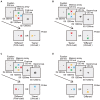The effects of sequential attention shifts within visual working memory
- PMID: 25237306
- PMCID: PMC4154591
- DOI: 10.3389/fpsyg.2014.00965
The effects of sequential attention shifts within visual working memory
Abstract
Previous studies have shown conflicting data as to whether it is possible to sequentially shift spatial attention among visual working memory (VWM) representations. The present study investigated this issue by asynchronously presenting attentional cues during the retention interval of a change detection task. In particular, we focused on two types of sequential attention shifts: (1) orienting attention to one location, and then withdrawing attention from it, and (2) switching the focus of attention from one location to another. In Experiment 1, a withdrawal cue was presented after a spatial retro-cue to measure the effect of withdrawing attention. The withdrawal cue significantly reduced the cost of invalid spatial cues, but surprisingly, did not attenuate the benefit of valid spatial cues. This indicates that the withdrawal cue only triggered the activation of facilitative components but not inhibitory components of attention. In Experiment 2, two spatial retro-cues were presented successively to examine the effect of switching the focus of attention. We observed equivalent benefits of the first and second spatial cues, suggesting that participants were able to reorient attention from one location to another within VWM, and the reallocation of attention did not attenuate memory at the first-cued location. In Experiment 3, we found that reducing the validity of the preceding spatial cue did lead to a significant reduction in its benefit. However, performance was still better at first-cued locations than at uncued and neutral locations, indicating that the first cue benefit might have been preserved both partially under automatic control and partially under voluntary control. Our findings revealed new properties of dynamic attentional control in VWM maintenance.
Keywords: attention; retro-cue; selective maintenance; sequential cueing; visual working memory.
Figures






Similar articles
-
Comparing retro-cue benefit mechanisms in visual working memory: completely valid vs. highly valid retro-cues.BMC Psychol. 2024 Nov 7;12(1):639. doi: 10.1186/s40359-024-02145-2. BMC Psychol. 2024. PMID: 39511694 Free PMC article.
-
Social attention directs working memory maintenance.Cognition. 2018 Feb;171:85-94. doi: 10.1016/j.cognition.2017.10.025. Epub 2017 Nov 7. Cognition. 2018. PMID: 29121587
-
The impact of retro-cue validity on working memory representation: Evidence from electroencephalograms.Biol Psychol. 2022 Apr;170:108320. doi: 10.1016/j.biopsycho.2022.108320. Epub 2022 Mar 23. Biol Psychol. 2022. PMID: 35337895
-
Spatial attention based on 2D location and relative depth order modulates visual working memory in a 3D environment.Br J Psychol. 2023 Feb;114(1):112-131. doi: 10.1111/bjop.12599. Epub 2022 Sep 25. Br J Psychol. 2023. PMID: 36161427
-
Dimension-based retro-cue benefit in working memory does not require unfocused dimension removal.Front Psychol. 2024 Nov 1;15:1433405. doi: 10.3389/fpsyg.2024.1433405. eCollection 2024. Front Psychol. 2024. PMID: 39554712 Free PMC article.
Cited by
-
Retro-dimension-cue benefit in visual working memory.Sci Rep. 2016 Oct 24;6:35573. doi: 10.1038/srep35573. Sci Rep. 2016. PMID: 27774983 Free PMC article.
-
Effect of attentional selection on working memory for depth in a retro-cueing paradigm.Mem Cognit. 2021 May;49(4):747-757. doi: 10.3758/s13421-020-01123-4. Epub 2021 Jan 7. Mem Cognit. 2021. PMID: 33415712
-
Development of a Battery to Assess Perceptual-Motor, Cognition, Language, and Scholastic Skills among Bengali Children with Neuro Developmental Disorders.Indian J Psychol Med. 2020 Apr 25;42(3):238-249. doi: 10.4103/IJPSYM.IJPSYM_198_19. eCollection 2020 May-Jun. Indian J Psychol Med. 2020. PMID: 32612328 Free PMC article.
-
Retrospective cue benefits in visual working memory are limited to a single location at a time.Atten Percept Psychophys. 2023 Jul;85(5):1474-1485. doi: 10.3758/s13414-023-02661-0. Epub 2023 Feb 2. Atten Percept Psychophys. 2023. PMID: 36732427
-
Prioritizing Information during Working Memory: Beyond Sustained Internal Attention.Trends Cogn Sci. 2017 Jun;21(6):449-461. doi: 10.1016/j.tics.2017.03.010. Epub 2017 Apr 25. Trends Cogn Sci. 2017. PMID: 28454719 Free PMC article. Review.
References
-
- Baddeley A. D., Hitch G. (1974). “Working memory,” in Recent Advances in Learning and Motivation ed. Bower G. A. (New York: Academic Press) 647–667
LinkOut - more resources
Full Text Sources
Other Literature Sources

